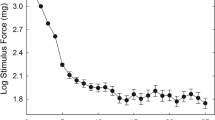Summary
The effect of movement of the index finger on the perceived intensity of trains of electrical stimuli to the digital nerves of the same finger was studied quantitatively using a novel intramodality stimulus-matching task. Subjects consistently were able to match reliably the perceived intensity of stimuli delivered on the ‘reference’ side with that of stimuli delivered simultaneously to the digital nerves of the index finger on the other (‘matching’) side. Both active and passive movement of the index finger (on the reference side) in the palmar plane reduced the matched stimulus voltage by about 10% of its control value for stimuli at twice the sensory threshold. This reduction in perceived intensity did not persist beyond the period of stimulation. An isometric contraction of first dorsal interosseous muscle produced a smaller, but statistically significant, reduction in perceived intensity. Non-noxious electrical stimulation of the digital nerves of the ipsilateral thumb or little finger also reduced the perceived intensity of stimuli to the index finger. Perceived intensity of stimuli during movement was also reduced, but to a lesser extent, when the index finger was stimulated at painful levels. Psychophysical studies using open magnitude scaling indicated that the relationship between stimulus intensity and perceived magnitude of electrical stimuli could be described by a power law with an exponent close to 1.0. Therefore, the percentage reduction in matching voltage accurately represents the percentage decline in perceived intensity. These results suggest that the perceived intensity of cutaneous stimuli to the index finger over a range of intensities can be reduced by afferent activity from the hand. The motor command appears to play a relatively minor role in modulating the perceived intensity.
Similar content being viewed by others
References
Abbruzzese G, Ratto S, Favale E, Abbruzzese M (1981) Proprioceptive modulation of somatosensory evoked potentials during active or passive finger movements in man. J Neurol Neurosurg Psychiat 44: 942–949
Angel RW, Malenka RC (1982) Velocity-dependent suppression of cutaneous sensitivity during movement. Exp Neurol 77: 266–274
Bromm B (1984) Pain-related components in the cerebral potential. Experimental and multivariate statistical approaches. In: Bromm B (ed) Pain measurements in man. Neurophysiological correlates of pain. Elsevier, Amsterdam, pp 257–289
Bromm B, Treede R-D (1980) Withdrawal reflex, skin resistance reaction and pain ratings due to electrical stimuli in man. Pain 9: 339–354
Burke D, Gandevia SC, McKeon B, Skuse NF (1982) Interactions between cutaneous and muscle afferent projections to cerebral cortex in man. Electroenceph Clin Neurophysiol 53: 349–360
Chapman CR, Jacobson RC (1984) Assessment of analgesic states: can evoked potentials play a role? In: Bromm B (ed) Pain measurement in man. Neurophysiological correlates of pain. Elsevier, Amsterdam, pp 233–255
Coquery J-M (1978) Role of active movement in control of afferent input from skin in cat and man. In: Gordon G (ed) Active touch. Pergamon, Oxford, pp 161–169
Dyhre-Poulsen P (1975) Increased vibration threshold before movements in human subjects. Exp Neurol 47: 516–522
Ferrington DG, Nail BS, Rowe M (1977) Human tactile detection thresholds: modification by inputs from specific tactile receptor classes. J Physiol 272: 415–433
Gandevia SC, Burke D (1984) Saturation in human somatosensory pathways. Exp Brain Res 54: 582–585
Gandevia SC, Burke D (1985) Effects of training on voluntary activation of human fusimotor neurons. J Neurophysiol 54: 922–931
Gandevia SC, McCloskey DI (1977) Effects of related sensory inputs on motor performance in man studied through changes in perceived heaviness. J Physiol 272: 653–672
Gandevia SC, Burke D, McKeon B (1983) Convergence in the somatosensory pathway between cutaneous afferents from the index and middle fingers in man. Exp Brain Res 50: 415–425
Garland HT, Angel RW (1974) Modulation of tactile sensitivity during movement. Neurology 24: 361 (Abstract)
Kirk RE (1982) Experimental design. Procedures for the behavioural sciences, 2nd edn. Brooks-Cole Publishing Co, California
Lee RG, White DG (1974) Modification of the somatosensory evoked response during movement. Electroenceph Clin Neurophysiol 36: 53–62
Martin JH, Zambelli A, Bando T, Spencer WA (1985) Mechanoreceptive submodality channel interactions: psychophysical observations on differential activation of flutter and vibration. Brain Res 327: 269–277
Milne RJ, Aniss AM, Gandevia SC (1986) Reduction in perceived intensity of cutaneous stimuli during movement. Neuroscience Abstr 12 (1): 224
Papakostopoulos D, Cooper R, Crow HJ (1975) Inhibition of cortical evoked potentials and sensation by self-initiated movement in man. Nature 258: 321–324
Rauch R, Angel RW, Boylls CC (1985) Velocity-dependent suppression of somatosensory evoked potentials during movement. Electroenceph Clin Neurophysiol 62: 421–425
Regan D (1972) Evoked potentials in psychology, sensory physiology and clinical medicine. Chapman & Hall, London, pp 42–45
Rushton DN, Rothwell JC, Craggs MD (1981) Gating of somatosensory evoked potentials during different kinds of movement in man. Brain 104: 465–491
Starr A, Cohen LG (1985) ‘Gating’ of somatosensory evoked potentials begins before the onset of voluntary movement in man. Brain Res 348: 183–186
Stevens SS (1975) Psychophysics. Introduction to the perceptual, neural, and social prospects. Wiley, New York, pp 1–36
Author information
Authors and Affiliations
Rights and permissions
About this article
Cite this article
Milne, R.J., Aniss, A.M., Kay, N.E. et al. Reduction in perceived intensity of cutaneous stimuli during movement: a quantitative study. Exp Brain Res 70, 569–576 (1988). https://doi.org/10.1007/BF00247604
Received:
Accepted:
Issue Date:
DOI: https://doi.org/10.1007/BF00247604




